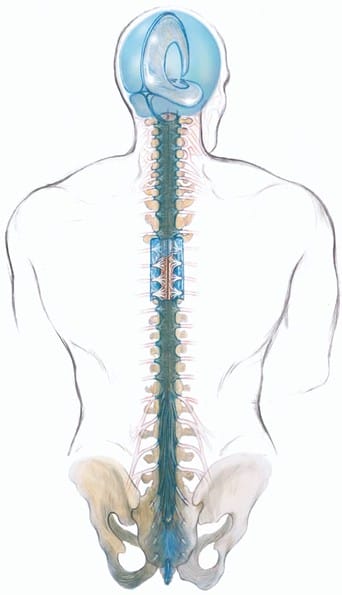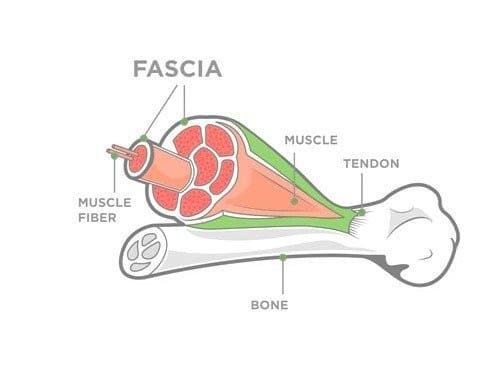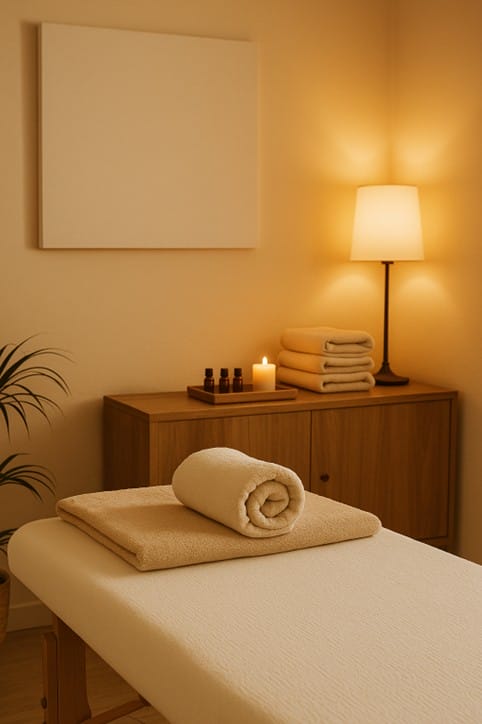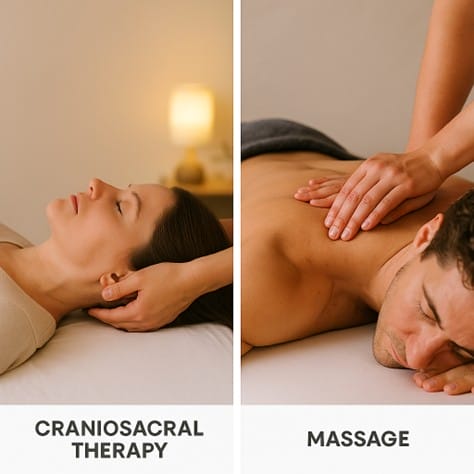Craniosacral Therapy in Edmonton: A Gentle Approach to Deep Healing
What If Healing Didn’t Have to Hurt?
Let’s be honest—most of us are used to the idea that healing requires effort, pressure, or even a bit of discomfort. Whether it’s a deep-tissue massage, a punishing workout, or a long therapy session, there’s this unspoken rule that “if it doesn’t hurt, it doesn’t help.”
But what if your body could release stress, chronic pain, and years of emotional tension… without force?
That’s the idea behind craniosacral therapy—a gentle, non-invasive treatment that’s quietly changing lives for people right here in Edmonton. It’s subtle, but powerful. Relaxing, yet profoundly healing. And for many, it works when nothing else has.
If you’ve been spinning your wheels trying to deal with migraines, anxiety, neck tension, trauma, or burnout, craniosacral therapy might just be the reset your nervous system has been begging for.
And the best part? You barely have to do anything at all.
“Craniosacral therapy supports the nervous system’s natural rhythm—helping it shift from fight-or-flight to a more balanced, self-regulating state.”
— Dr. John Upledger, Founder of the Upledger Institute and pioneer of CST
Source: Upledger Institute International
Whether you’re new to holistic therapies or you’ve already tried everything under the sun, this blog will walk you through:
- What craniosacral therapy actually is (and isn’t)
- How it works on your brain and body without pushing or pulling
- Who it’s best suited for
- What to expect from a session
- And where to try craniosacral therapy in Edmonton—with professionals who know how to listen to your body, not just treat it
Ready to find out if this underrated therapy is what your body’s been asking for? Let’s dig in.
What Is Craniosacral Therapy, Exactly?
If the term craniosacral therapy sounds a little medical or intimidating, don’t worry—it’s much simpler (and gentler) than it sounds.
At its core, craniosacral therapy (CST) is a hands-on healing technique that uses extremely light touch—sometimes no more than the weight of a nickel—to help your body release tension and restore balance in the central nervous system.
It focuses on the craniosacral system, which includes:
- Your brain and spinal cord
- The membranes that surround them
- The cerebrospinal fluid (CSF) that cushions and nourishes your nervous system
That system has a natural rhythm—just like your heartbeat or breathing. But when the rhythm is off, due to injury, stress, trauma, or chronic tension, it can affect everything from your sleep and digestion to your emotional wellbeing and pain levels.

The Origin Story: Dr. John Upledger and the Birth of CST
CST as we know it today was developed by Dr. John Upledger, an osteopathic physician who first observed the craniosacral rhythm while assisting in a spinal surgery in the 1970s. What caught his attention? The dura mater (a membrane surrounding the spinal cord) moved in a consistent rhythm—separate from the patient’s heartbeat or breath.
That sparked years of research and eventually the creation of the Upledger Institute, which now trains therapists worldwide in this method.
“The craniosacral system influences the development and performance of the brain and spinal cord. An imbalance or restriction in it could potentially cause any number of sensory, motor or neurological disabilities.”
— Upledger Institute International
The Science Behind the Touch
One of the first questions people ask is:
“Can something that gentle really work?”
It’s a fair question. We’re used to associating healing with intensity—sweat, strain, or deep pressure. So when a therapy involves little more than resting hands on the body, it can feel… suspiciously simple.
But simplicity doesn’t mean ineffectiveness. In fact, in a world overstimulated by chronic stress, subtle therapy may be exactly what your nervous system needs.
Light Touch, Deep Effects: How It Works
Craniosacral therapy works by detecting and gently releasing restrictions in the fascia—a web of connective tissue that surrounds every muscle, organ, and nerve in your body.
Fascia is incredibly sensitive. According to a study in the Journal of Bodywork and Movement Therapies, it can respond to just five grams of pressure—the weight of a nickel. That’s the same amount of pressure CST therapists use.

The theory is this:
By releasing tension in the craniosacral system, the flow of cerebrospinal fluid is improved. This helps the brain and spinal cord operate more smoothly, reducing irritation in the nervous system and supporting better whole-body function.
“Light-touch manual therapy techniques can affect the autonomic nervous system, including lowering heart rate and promoting parasympathetic activation.”
— Journal of Alternative and Complementary Medicine, 2011
Balancing the Autonomic Nervous System
One of CST’s most powerful effects is its ability to soothe the autonomic nervous system—the part of your body that controls involuntary functions like heartbeat, digestion, and breathing.
Here’s the thing: when you’re constantly in “fight or flight” mode, even at low levels, your body never fully heals. You might feel restless, inflamed, or anxious without knowing why.
CST helps restore balance between your sympathetic (fight or flight) and parasympathetic (rest and digest) systems—guiding your body back into a state of regulation and repair.
What Does the Research Say?
While craniosacral therapy has critics (especially in clinical circles that want more large-scale studies), there is a growing body of research that supports its benefits.
Here’s a snapshot of what recent findings have shown:
- A 2016 systematic review published in BMC Complementary Medicine and Therapies found moderate-quality evidence that CST can reduce pain intensity and improve physical function in clients with chronic neck and back pain.
- CST has been shown to help improve migraine frequency and intensity, according to a controlled study in Headache: The Journal of Head and Face Pain.
- Other pilot studies suggest benefits for fibromyalgia, TMJ disorders, and anxiety, though more research is needed for clinical standardization.
When Less Is More
If you’ve ever felt overwhelmed by deep-tissue massage, chiropractic adjustments, or even traditional talk therapy, CST offers a different door.
It’s not about “fixing” your body.
It’s about creating space for your body to heal itself.
In fact, some of our Edmonton-based clients describe it as a “soft reboot”—like turning your nervous system off and back on again, but gently.
💡 Want to learn how CST compares to other healing techniques like reflexology or massage therapy? Check out our guide on reflexology in Edmonton.
The Real Benefits of Craniosacral Therapy
Whether you’re dealing with chronic pain, lingering stress, or that foggy “off” feeling you can’t quite name, craniosacral therapy (CST) has a reputation for helping people feel more like themselves again. And no, it’s not just placebo or hype. The effects are real—and often deeply life-changing.
1. Migraine and Headache Relief
If you live with recurring migraines or tension headaches, you already know how disruptive they can be. CST may help by:
- Releasing tension in the head, neck, and cranial membranes
- Improving blood flow and cerebrospinal fluid circulation
- Calming the nervous system’s overactivity
A 2012 study published in Headache found that clients who received craniosacral therapy had significantly fewer migraine days and reduced medication use.
2. Chronic Pain Support
Whether it’s low back pain, TMJ, neck tension, or fibromyalgia, CST is often sought out by people who’ve tried everything else.
Because CST addresses tension and restriction in the deep fascia and craniosacral membranes, it helps reduce physical pain without adding more stress to already-sensitive tissues.
Many clients in Edmonton seek craniosacral therapy for:
- TMJ dysfunction
- Whiplash injuries
- Sciatica or sacral pain
- Chronic tension in the jaw, shoulders, or spine
3. Anxiety and Emotional Regulation
This is where CST really shines.
Unlike some bodywork that stimulates your system, CST helps regulate your parasympathetic nervous system—the part of your body that governs rest, digestion, and emotional recovery.
For people with anxiety, PTSD, or burnout, CST can offer:
- Deep physical relaxation without feeling overwhelmed
- Emotional release without needing to talk
- A felt sense of calm and internal safety
“Many people don’t realise how much emotion is stored in the body. CST helps people reconnect, release, and reset—often in ways they weren’t even aware they needed.”
— Sangeeta Sirohi, Registered Clinical Counsellor & Holistic Practitioner
4. Better Sleep and Nervous System Balance
Sleep problems aren’t always about habits—they’re often about the nervous system being stuck in high alert.
CST helps shift the body out of this hypervigilant state, promoting restful sleep and better circadian regulation. After a few sessions, many clients report:
- Falling asleep faster
- Staying asleep longer
- Waking up less tense
5. Enhanced Body Awareness and Recovery
CST helps people tune in to subtle patterns in their body—something we often ignore until pain becomes loud.
Many athletes, dancers, yoga teachers, and recovering clients report that CST:
- Improves body alignment and movement efficiency
- Speeds recovery after injury or surgery
- Enhances the mind-body connection
If you’re exploring complementary healing or already receiving massage therapy, CST can be a powerful addition to your care plan.
What to Expect During a Craniosacral Therapy Session
Let’s be honest—trying a new therapy can feel intimidating, especially when you don’t know what’s going to happen. You might be wondering:
“Do I have to take my clothes off?”
“Will it hurt?”
“What am I supposed to feel?”
We get it. So let’s walk you through exactly what a craniosacral therapy (CST) session looks like—from the moment you arrive to the moment you walk out feeling more grounded and calm.

The Setup: Simple, Comfortable, Quiet
First things first: you’ll stay fully clothed.
Wear something comfortable—yoga pants, sweats, or whatever lets you relax. The session takes place on a massage table in a quiet, softly lit room. No oils. No music unless you want it. Just space to breathe.
Before your session starts, your therapist may ask a few gentle questions about:
- Why you’re seeking treatment (e.g., pain, migraines, anxiety, trauma)
- Any past injuries, surgeries, or sensitivities
- What you’re hoping to get out of the session
This isn’t a deep dive like talk therapy—but it’s helpful context so they can support your nervous system appropriately.
The Technique: Gentle, Mindful Touch
The therapist will place their hands lightly on specific areas of your body—often starting at the skull, spine, sacrum, or feet. Sometimes they stay in one spot for several minutes. Other times, they’ll move gently along the head, neck, or torso.
The touch is incredibly light—about the weight of a nickel. And yet, it often triggers noticeable sensations: warmth, tingling, waves of release, or deep stillness. Some people fall asleep. Others feel emotional. And some feel very little at all during the session—but notice big changes after.
There’s no pressure to “perform” or feel a certain way. Your only job is to rest and notice what arises—if anything.
How Long Does a Session Last?
Most craniosacral therapy sessions are 60 minutes, though some practitioners offer 75- or 90-minute options.
You may feel subtle shifts after the first visit, or it might take a few sessions to notice results—especially if your nervous system has been on high alert for a long time.
If you’re dealing with chronic pain, trauma, or burnout, your body might need several visits before it feels safe enough to release tension. That’s normal. Healing isn’t a race.
After the Session: The Soft Reset
Many people report feeling:
- Calmer
- Lighter
- Sleepy or deeply relaxed
- More emotionally centred
You might also feel energized, or notice a reduction in physical symptoms like pain, jaw tension, or headaches.
It’s a good idea to drink water, avoid overstimulation, and give yourself space to process—especially if emotions or memories surfaced during the session.
💡 Curious how CST fits into your overall wellness plan? It often pairs beautifully with Edmonton reflexology and massage therapy. These modalities support the body in different but complementary ways.
Who Is Craniosacral Therapy For?
Craniosacral therapy isn’t just for one type of person. It’s not just for “crunchy granola” folks or people recovering from serious trauma. It’s for anyone whose body is holding tension—and let’s be real, in today’s world, that’s most of us.
Here’s a look at who benefits most from craniosacral therapy—and a few cases where it might not be the right fit.

Ideal Candidates for Craniosacral Therapy
People with Chronic Stress or Burnout
If your body constantly feels like it’s bracing for impact, CST can help switch off that survival mode and ease you into a rest-and-digest state.
Individuals with Trauma (Physical or Emotional)
CST is frequently used to support trauma recovery—not by rehashing the story, but by helping the body process what talk therapy can’t always reach. Many trauma-informed therapists recommend CST as a somatic complement to counselling.
Migraine and Headache Sufferers
People with migraines, tension headaches, and TMJ pain often find CST offers relief they couldn’t get from medication or chiropractic care.
Sleep-Deprived or Nervous System Dysregulated Clients
When your body can’t seem to slow down or switch off, CST helps recalibrate your internal rhythms.
Clients in Post-Surgical or Injury Recovery
Especially when there’s scar tissue or postural compensation at play, CST can support smoother healing by releasing fascial restrictions and improving alignment.
Pregnant Women and New Mothers
With approval from a healthcare provider, CST can be a gentle option during pregnancy or postpartum recovery, easing pelvic tension and calming the nervous system.
Infants and Children
Yes—babies and kids benefit too. CST is used to help with colic, latch difficulties, developmental delays, and even behavioural regulation.

When Craniosacral Therapy Might Not Be Right
While CST is incredibly gentle and low-risk, it’s not appropriate for everyone.
It’s important to consult a physician first if you have:
- Recent head trauma, stroke, or aneurysm
- Acute bleeding disorders or severe clotting issues
- Chiari malformation or intracranial pressure problems
- Severe instability in the spine or cranial bones
As always, CST is a complementary therapy—not a substitute for emergency care, surgery, or primary medical treatment.
Still Not Sure If It’s Right for You?
If you’re on the fence, ask yourself:
- Do I feel like I’m carrying stress I can’t quite shake?
- Have traditional treatments helped… but only a little?
- Am I open to trying a body-based, non-invasive therapy?
If you answered yes to any of these, CST may be a safe and effective next step.
📍 Want to explore CST alongside other holistic care options? Many clients combine craniosacral therapy with massage or reflexology for full-body nervous system support.
How Craniosacral Therapy Compares to Other Modalities
Not sure how craniosacral therapy fits into the bigger picture of wellness? Here’s how it stacks up next to other common treatments.

CST vs. Massage Therapy
Massage focuses on muscles and uses pressure to release tension.
CST works with the nervous system and fascia using feather-light touch.
Massage is great for:
- Immediate physical relief
- Muscle recovery
- Circulation
CST is ideal for:
- Nervous system regulation
- Chronic conditions
- Emotional release
Many clients in Edmonton choose to alternate CST with massage therapy for a full-spectrum approach.
CST vs. Reflexology
Reflexology uses pressure points on the feet, hands, or ears to support organ health.
CST works with the entire craniosacral rhythm to release restrictions throughout the body.
Reflexology = targeted stimulation
CST = whole-body rebalancing
Combine both if you want a blend of structure and flow.
CST vs. Chiropractic Adjustments
Chiropractic uses quick, manual adjustments to realign the spine.
CST uses gentle, sustained holds to ease restrictions in soft tissue.
If you’re sensitive to cracking or forceful manipulation, CST may feel more comfortable.
CST vs. Counselling (Talk Therapy)
Counselling helps you process emotions through conversation.
CST supports emotional release stored in the body—no talking required.
They’re not either/or—many trauma-informed therapists recommend CST alongside counselling for deeper healing.
“The body keeps the score, but it also holds the solution. CST gives your system the safety it needs to let go.”
— Sangeeta Sirohi, RCC
Bottom line? CST is a quiet complement—not a replacement—for other therapies. It works best when integrated into your larger wellness plan.
Final Thoughts: Gentle Therapy, Deep Healing
Craniosacral therapy isn’t flashy.
It doesn’t crack, pull, or pound.
But if you’ve been carrying stress, pain, or emotional weight for too long—it might be exactly what your body needs.
Here’s what we’ve covered:
- CST works with your body’s natural rhythm to release tension at the source.
- It’s ideal for migraines, anxiety, chronic pain, nervous system overload, and trauma recovery.
- It’s deeply relaxing, non-invasive, and often works when other therapies fall short.
And most importantly: it’s about listening, not forcing. Healing, not fixing.
Ready to Try Craniosacral Therapy in Edmonton?
At The Self Centre, our experienced practitioners offer craniosacral therapy with skill, compassion, and respect for your unique body. Whether you’re just starting your wellness journey or adding to an existing routine, CST can be a quiet but powerful reset.
🗓️ Book your session today:
👉 Schedule Online
Conveniently located in South Edmonton
Direct billing available for many providers
Looking for something more targeted? You can also explore our related services:
- Massage Therapy in Edmonton
- Reflexology in Edmonton
Gentle touch. Powerful results.
Your nervous system will thank you.



